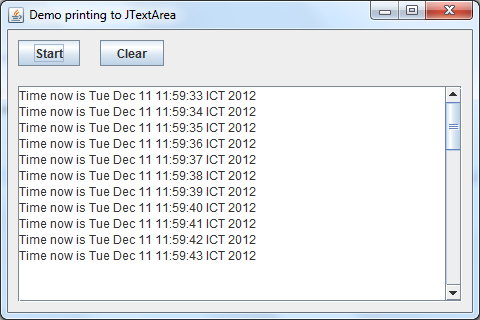Redirect standard output streams to JTextArea
- Details
- Written by Nam Ha Minh
- Last Updated on 06 July 2019 | Print Email
For Java developers, it’s very common for using these well-known statements:
System.out.print("something");
System.out.println("one more thing");to print some text on the standard output console for the purpose of debugging and testing. However, there would be some cases in which we want the text goes into a Swing component such as a JTextArea, rather than into the standard output console. This article describes how to make that possible with a small example program.
The main idea is based on the two methods provided by the System class:
- System.setOut(PrintStream): Re-assigns the standard output stream.
- System.setErr(PrintStream): Re-assigns the standard error output stream.
Create a sub class of OutputStream class like this:
package net.codejava.swing;
import java.io.IOException;
import java.io.OutputStream;
import javax.swing.JTextArea;
/**
* This class extends from OutputStream to redirect output to a JTextArrea
* @author www.codejava.net
*
*/
public class CustomOutputStream extends OutputStream {
private JTextArea textArea;
public CustomOutputStream(JTextArea textArea) {
this.textArea = textArea;
}
@Override
public void write(int b) throws IOException {
// redirects data to the text area
textArea.append(String.valueOf((char)b));
// scrolls the text area to the end of data
textArea.setCaretPosition(textArea.getDocument().getLength());
}
}
As we can see, the constructor takes a JTextArea object as argument and overrides the write(int) method from the OutputStream class. In the write() method, we convert the byte to a character and append it to the JTextArea. So everything written to this output stream will be placed into the text area. Then we can re-assign the standard output streams as follows:
JTextArea textArea = new JTextArea(50, 10); PrintStream printStream = new PrintStream(new CustomOutputStream(textArea)); System.setOut(printStream); System.setErr(printStream);
If we still want to use the standard output streams, we have to keep references to them before re-assigning, for example:
PrintStream standardOut = System.out; PrintStream standardErr = System.err;
Following is a sample Swing program that displays a text area with two buttons:

Clicking on Start button will start a new thread which prints a log statement for every one second. The Clear button will clear the text area.
Here is code of the program:
package net.codejava.swing;
import java.awt.GridBagConstraints;
import java.awt.GridBagLayout;
import java.awt.Insets;
import java.awt.event.ActionEvent;
import java.awt.event.ActionListener;
import java.io.PrintStream;
import java.util.Date;
import javax.swing.JButton;
import javax.swing.JFrame;
import javax.swing.JScrollPane;
import javax.swing.JTextArea;
import javax.swing.SwingUtilities;
import javax.swing.text.BadLocationException;
public class TextAreaLogProgram extends JFrame {
/**
* The text area which is used for displaying logging information.
*/
private JTextArea textArea;
private JButton buttonStart = new JButton("Start");
private JButton buttonClear = new JButton("Clear");
private PrintStream standardOut;
public TextAreaLogProgram() {
super("Demo printing to JTextArea");
textArea = new JTextArea(50, 10);
textArea.setEditable(false);
PrintStream printStream = new PrintStream(new CustomOutputStream(textArea));
// keeps reference of standard output stream
standardOut = System.out;
// re-assigns standard output stream and error output stream
System.setOut(printStream);
System.setErr(printStream);
// creates the GUI
setLayout(new GridBagLayout());
GridBagConstraints constraints = new GridBagConstraints();
constraints.gridx = 0;
constraints.gridy = 0;
constraints.insets = new Insets(10, 10, 10, 10);
constraints.anchor = GridBagConstraints.WEST;
add(buttonStart, constraints);
constraints.gridx = 1;
add(buttonClear, constraints);
constraints.gridx = 0;
constraints.gridy = 1;
constraints.gridwidth = 2;
constraints.fill = GridBagConstraints.BOTH;
constraints.weightx = 1.0;
constraints.weighty = 1.0;
add(new JScrollPane(textArea), constraints);
// adds event handler for button Start
buttonStart.addActionListener(new ActionListener() {
@Override
public void actionPerformed(ActionEvent evt) {
printLog();
}
});
// adds event handler for button Clear
buttonClear.addActionListener(new ActionListener() {
@Override
public void actionPerformed(ActionEvent evt) {
// clears the text area
try {
textArea.getDocument().remove(0,
textArea.getDocument().getLength());
standardOut.println("Text area cleared");
} catch (BadLocationException ex) {
ex.printStackTrace();
}
}
});
setDefaultCloseOperation(JFrame.EXIT_ON_CLOSE);
setSize(480, 320);
setLocationRelativeTo(null); // centers on screen
}
/**
* Prints log statements for testing in a thread
*/
private void printLog() {
Thread thread = new Thread(new Runnable() {
@Override
public void run() {
while (true) {
System.out.println("Time now is " + (new Date()));
try {
Thread.sleep(1000);
} catch (InterruptedException ex) {
ex.printStackTrace();
}
}
}
});
thread.start();
}
/**
* Runs the program
*/
public static void main(String[] args) {
SwingUtilities.invokeLater(new Runnable() {
@Override
public void run() {
new TextAreaLogProgram().setVisible(true);
}
});
}
}
Other Java Swing Tutorials:
- Java Swing Hello World Tutorial for Beginners Using Text Editor
- JFrame basic tutorial and examples
- JPanel basic tutorial and examples
- JLabel basic tutorial and examples
- JTextField basic tutorial and examples
- JButton basic tutorial and examples
- JComboBox basic tutorial and examples
- JCheckBox basic tutorial and examples
- JList basic tutorial and examples
About the Author:
 Nam Ha Minh is certified Java programmer (SCJP and SCWCD). He began programming with Java back in the days of Java 1.4 and has been passionate about it ever since. You can connect with him on Facebook and watch his Java videos on YouTube.
Nam Ha Minh is certified Java programmer (SCJP and SCWCD). He began programming with Java back in the days of Java 1.4 and has been passionate about it ever since. You can connect with him on Facebook and watch his Java videos on YouTube.
Comments
thankyou!!!!!!!!!
i will use it many times from now on